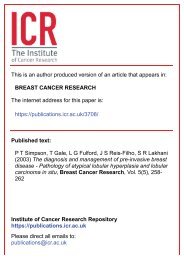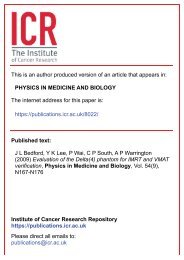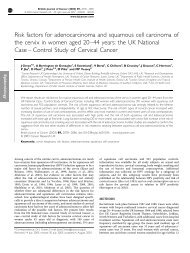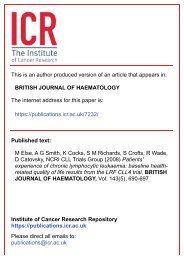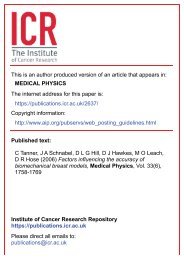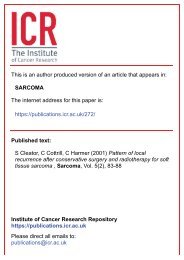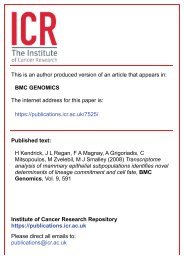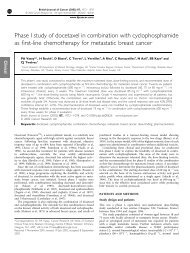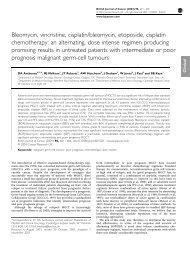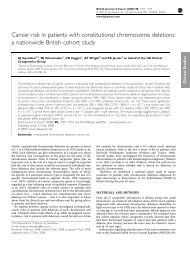Glomerular filtration rate prior to high-dose melphalan 200 mg/m2 as ...
Glomerular filtration rate prior to high-dose melphalan 200 mg/m2 as ...
Glomerular filtration rate prior to high-dose melphalan 200 mg/m2 as ...
Create successful ePaper yourself
Turn your PDF publications into a flip-book with our unique Google optimized e-Paper software.
British Journal of Cancer (<strong>200</strong>1) 85(3), 325–332© <strong>200</strong>1 Cancer Research Campaigndoi: 10.1054/ bjoc.<strong>200</strong>0.1928, available online at http://www.idealibrary.com onhttp://www.bjcancer.com<strong>Glomerular</strong> <strong>filtration</strong> <strong>rate</strong> <strong>prior</strong> <strong>to</strong> <strong>high</strong>-<strong>dose</strong> <strong>melphalan</strong><strong>200</strong> <strong>mg</strong>/m 2 <strong>as</strong> a surrogate marker of outcome in patientswith myelomaB Sirohi, R Powles, S Kulkarni, C Rudin, R S<strong>as</strong>o, A Rigg, C Hor<strong>to</strong>n, S Singhal 1 , J Mehta 1 and J TreleavenLeukaemia and Myeloma Units, Royal Marsden NHS Trust, Surrey, UKSummary We correlated age and body surface area corrected glomerular <strong>filtration</strong> <strong>rate</strong> (GFR) at the time of <strong>high</strong>-<strong>dose</strong> <strong>melphalan</strong> (HDM)administration with treatment-related <strong>to</strong>xicity (TT), time <strong>to</strong> dise<strong>as</strong>e progression and survival. Between 8/85 and 6/98, 144 newly diagnosedmyeloma patients with a median age of 53 years (range, 31–72) received infusional chemotherapy with vincristine, doxorubicin andmethylprednisolone, with/without cyclophosphamide or verapamil, followed by HDM <strong>200</strong> <strong>mg</strong>/m 2 and stem cell rescue. An additional patientreceived HDM at diagnosis. GFR w<strong>as</strong> below normal in 38 patients (26%). At presentation, patients with low GFR at the time of HDM had<strong>high</strong>er serum creatinine, β 2M, stage III dise<strong>as</strong>e, calcium and Bence–Jones proteinuria. Toxic deaths post-HDM were similar in both groups(2/38 (5%) vs. 4/107 (4%)), though patients with low GFR had more oral mucositis (P < 0.0001), diarrhoea (P = 0.005) and infections (P =0.04). The response and relapse <strong>rate</strong>s of the 2 groups were not substantially different, but the median overall survival (OS) w<strong>as</strong> significantlyshorter in patients with low GFR (5.1 vs 7.5 years, P = 0.015). Multivariate analysis showed that a normal GFR and being in CR at the time ofHDM were predictive of longer OS. We conclude that in context of <strong>high</strong>-<strong>dose</strong> chemotherapy for myeloma, <strong>dose</strong> of <strong>melphalan</strong> should not bemodified in patients with low GFR and that early intensive treatment at relapse may improve results in patients with abnormal renal function.© <strong>200</strong>1 Cancer Research Campaign http://www.bjcancer.comKeywords: myeloma; glomerular <strong>filtration</strong> <strong>rate</strong>; morbidity; outcomeRenal function is one of the most important prognostic fac<strong>to</strong>rs inpatients with multiple myeloma (Durie and Salmon, 1975). Duringthe l<strong>as</strong>t 20 years myeloma treatment h<strong>as</strong> changed substantiallyand now typically constitutes initial courses of infusionalchemotherapy (IC) with VAMP/C-VAMP/VAD (vincristine,doxorubicin, and methylprednisolone or dexameth<strong>as</strong>one with orwithout cyclophosphamide) followed in approximately 70% ofpatients by consolidation with HDM and au<strong>to</strong>logous stem cellrescue with either cryopreserved marrow or peripheral blood stemcells (Powles et al, 1997; Barlogie et al, 1999). Au<strong>to</strong>transplantationis now considered for myeloma patients up <strong>to</strong> the age of75 (Siegel et al, <strong>200</strong>0, Sirohi et al, <strong>200</strong>0) which implies that themajority of patients with myeloma may benefit from this treatment.Patients with renal dysfunction, however, are frequentlyexcluded from <strong>high</strong> <strong>dose</strong> pro<strong>to</strong>cols, even though the c<strong>as</strong>e for thispractice h<strong>as</strong> been weakened since the French and Little Rockgroups have shown that renal insuffciency may not be a valid criterionfor exclusion from <strong>high</strong>-<strong>dose</strong> therapy programs (Kergueriset al, 1994; Tricot et al, 1996).We have previously reported that some patients who presentwith renal dysfunction recover normal renal function after IC,where<strong>as</strong> others go on <strong>to</strong> develop renal dysfunction during IC(Sirohi et al, 1999a). The purpose of the present observationalstudy w<strong>as</strong> <strong>to</strong> <strong>as</strong>sess whether renal function just <strong>prior</strong> <strong>to</strong> <strong>high</strong>-<strong>dose</strong>treatment is of prognostic value with respect <strong>to</strong> treatment-related<strong>to</strong>xicity, dise<strong>as</strong>e progression and survival. As me<strong>as</strong>ure of renalReceived 25 Oc<strong>to</strong>ber <strong>200</strong>0Revised 17 April <strong>200</strong>1Accepted 17 April <strong>200</strong>1Correspondence <strong>to</strong>: R Powlesfunction we used the glomerular <strong>filtration</strong> <strong>rate</strong> (GFR) corrected forage, determined not more than 30 days <strong>prior</strong> <strong>to</strong> the HDM. Allthe 145 patients described here were treated uniformly with HDM<strong>200</strong> <strong>mg</strong> m –2 .PATIENTS AND METHODSPatientsFrom a prospectively maintained datab<strong>as</strong>e, 145 newly diagnosedpatients with multiple myeloma who received HDM <strong>200</strong> <strong>mg</strong> m –2<strong>as</strong> consolidation therapy were analysed. They presented <strong>to</strong> our unitbetween August 1985 and June 1998. Written informed consent <strong>to</strong>treatment w<strong>as</strong> obtained according <strong>to</strong> institutional guidelines.TherapyInfusional chemotherapy (IC)Prior <strong>to</strong> the HDM, 144 patients were treated with infusionalchemotherapy (IC) with VAMP (n = 27), C-VAMP (n = 97) or V-C-VAMP (n = 20) (vincristine, doxorubicin, methylprednisolonewith or without cyclophosphamide or verapamil; Forgeson et al,1988; Raje et al, 1997a; Gore et al, 1988). All cycles were repeated3 weekly until maximum response and followed by an additionalcycle. One patient received HDM with an au<strong>to</strong>logous peripheralstem cell graft at diagnosis.Current address: 1 Division of Transplantation Medicine, South Carolina CancerCenter and Richland Memorial Hospital, Seven Richland Medical Park, Columbia,SC 29203325
326 B Sirohi et alPatient evaluation pre HDMAll patients who were planned <strong>to</strong> receive HDM 6 weeks after thel<strong>as</strong>t IC cycle had their GFR me<strong>as</strong>ured within 30 days before theHDM and this w<strong>as</strong> the most recent value. GFR w<strong>as</strong> <strong>as</strong>sessed by <strong>as</strong>tandard method using 51 Cr EDTA <strong>as</strong> tracer (Brochner-Morteson,1978) and corrected for body surface area (BSA) according <strong>to</strong> theformula Corrected GFR = Me<strong>as</strong>ured GFR × 1.73 / BSA.Age-adjusted normal ranges were taken <strong>as</strong>:20–39 years: 87–135 ml min –1 1.73 m –240–49 years: 80–128 ml min –1 1.73 m –250–59 years: 75–124 ml min –1 1.73 m –2< 60 years: 58–106 ml min –1 1.73 m –2GFR w<strong>as</strong> not routinely me<strong>as</strong>ured post HDM unless the patientsreceived a second course of <strong>high</strong>-<strong>dose</strong> therapy.A full blood count, clotting screen, serum biochemistry, paraprotein,immunoglobulin quantitation, β 2M, urinary Bence–Jonesprotein, bone marrow <strong>as</strong>pi<strong>rate</strong> and trephine biopsy, chest X-ray,electrocardiogram and, if indicated, MUGA scan, were carried outjust before the HDM.High-<strong>dose</strong> treatmentSince the publication of the reports by the French and Little Rockgroups (Kergueris et al, 1994; Tricot et al, 1996) and afterapproval by the institutional review board, HDM h<strong>as</strong> beenincluded in the core care plan for patients with myeloma andrenal impairment. All patients received <strong>melphalan</strong> at a <strong>dose</strong> of<strong>200</strong> <strong>mg</strong> m –2 on day –1 <strong>as</strong> a bolus injection. Adequate hydrationw<strong>as</strong> ensured <strong>to</strong> maintain a urine output of 20 ml min –1 during thefirst hour post <strong>high</strong> <strong>dose</strong> and 500 ml h –1 in the subsequent 2 hours.Patients received au<strong>to</strong>logous bone marrow (n = 69) untilNovember 1992 (Cunningham et al, 1994). The marrow w<strong>as</strong>harvested 6 weeks after the l<strong>as</strong>t chemotherapy cycle. The targetmononuclear cell count w<strong>as</strong> 2 <strong>to</strong> 5 × 10 8 cells kg –1 of body weight.From December 1992 onwards peripheral blood stem cell transplants(n = 76) were used. The G-CSF mobilization procedureemployed h<strong>as</strong> been previously described (Powles et al, 1997; Rajeet al, 1997b). The stem cells were infused 24 hours after the<strong>melphalan</strong>.All patients were admitted <strong>to</strong> a 4-bedded open ward on the firstday of conditioning and were nursed without barrier nursing. TheHickman lines inserted for IC were removed before HDM and allthe patients received anti-pneumocystis carinii prophylaxis in theform of nebulized Pentamidine 300 <strong>mg</strong> once a month (starting onday –1). Packed red cells and platelets were transfused <strong>to</strong> keep theHb> 9 gm dl –1 and platelets > 10 × 10 9 l –1 (in afebrile patients,> 20 × 10 9 l –1 in febrile patients). Fluid and electrolyte balance w<strong>as</strong>strictly maintained throughout the period of hospitalization. Gutsterilization w<strong>as</strong> not used. Patients were commenced on empiricalantibiotic therapy according <strong>to</strong> the hospital guidelines if pyrexia> 38˚C occurred. Mouth care included chlorhexidine mouthw<strong>as</strong>hes and nystatin suspension or amphotericin lozenges. Anormal diet w<strong>as</strong> encouraged. None of the patients required renalreplacement therapy during the au<strong>to</strong>transplantation.Maintenance therapy with interferonFrom July 1988 onwards, patients were started on maintenancetreatment with interferon alpha, (3 megaunits m –2 3 times a weeks/c) (Schering-Plough, Welwyn Garden City, Herts) followingtheir recovery from HDM. Initially this <strong>to</strong>ok place <strong>as</strong> part of arandomized trial, but subsequently interferon maintenance w<strong>as</strong>British Journal of Cancer (<strong>200</strong>1) 85(3), 325–332instituted in all patients <strong>as</strong> soon <strong>as</strong> the WBC count reached2 × 10 9 l –1 and the platelet count 50 × 10 9 l –1 . The <strong>dose</strong> of interferonw<strong>as</strong> reduced or s<strong>to</strong>pped according <strong>to</strong> the full blood count or other<strong>to</strong>xic manifestations (Cunningham et al, 1998).Evaluation of <strong>to</strong>xicityToxicity w<strong>as</strong> <strong>as</strong>sessed according <strong>to</strong> the WHO criteria (Miller et al,1981). The variables analysed for TT were recovery of neutrophils<strong>to</strong> > 0.5 × 10 9 l –1 , recovery of platelets <strong>to</strong> > 50 × 10 9 l –1 , days ofhospitalization, incidence of serum creatinine being > 177 µmol l –1(corresponding <strong>to</strong> stage B Durie–Salmon) during hospitalization,mucositis, diarrhoea, hepatic <strong>to</strong>xicity (bilirubin, transamin<strong>as</strong>es,alkaline phosphat<strong>as</strong>e) and microbiologically documented infection(DI). WHO grade III infections (mode<strong>rate</strong>) are defined <strong>as</strong> febrileneutropenia with pyrexia > 40˚C unresponsive <strong>to</strong> antibiotic andantifungal therapy. WHO grade IV infections (severe) areneutropenic fevers <strong>as</strong>sociated with hypotension. Toxicityw<strong>as</strong> attributed <strong>to</strong> HDM if it occurred during the patient’s hospitalizationfor the transplant or the first 60 days following thetransplant.Transplant-related death w<strong>as</strong> defined <strong>as</strong> death occurring duringthe first 60 days post au<strong>to</strong>graft not related <strong>to</strong> dise<strong>as</strong>e relapse.Evaluation of responseThe response in this group of patients h<strong>as</strong> been evaluated pre-HDM <strong>as</strong> well <strong>as</strong> 3 and 6 months post HDM. Our response criteriaand definition of complete remission (CR) have been describedearlier by Gore et al (1989). Briefly, four criteria needed <strong>to</strong> be met<strong>to</strong>gether for a patient <strong>to</strong> be regarded <strong>as</strong> having achieved CR: (1) nome<strong>as</strong>urable paraprotein on scanning densi<strong>to</strong>metry of serumproteins sepa<strong>rate</strong>d electrophoretically on a cellulose acetatemembrane and stained with ponceau S; (2) no detectable urinaryBence–Jones protein on electrophoresis of neat urine stained withcolloidal gold; (3) no more than 5% pl<strong>as</strong>ma cells of normalmorphology on the bone marrow <strong>as</strong>pi<strong>rate</strong> and a normal bonemarrow trephine biopsy; (4) stable skeletal appearances; (5)criteria 1–4 fulfilled for at le<strong>as</strong>t 3 consecutive months. Patientswere regarded <strong>as</strong> having achieved a partial response (PR) if therew<strong>as</strong> a 50% decre<strong>as</strong>e in me<strong>as</strong>urable paraprotein (IgG or IgAmyeloma) or bone marrow in<strong>filtration</strong> (in the c<strong>as</strong>e of nonsecre<strong>to</strong>ryor Bence–Jones myelom<strong>as</strong>) which w<strong>as</strong> sustained for atle<strong>as</strong>t a month or more. Relapse w<strong>as</strong> defined <strong>as</strong> either the reappearanceof the paraprotein on 2 samples taken one month apart (or a25% incre<strong>as</strong>e in paraprotein for patients in PR), bone marrow in<strong>filtration</strong>with more than 5% abnormal pl<strong>as</strong>ma cells, or developmen<strong>to</strong>f new osteolytic lesions (or progression of old lesions). Noresponse (NR) w<strong>as</strong> considered <strong>to</strong> have occurred if patients failed<strong>to</strong> achieve a CR or a PR or had progression of dise<strong>as</strong>e (PD).Patients were considered <strong>to</strong> be in continued complete remission(CCR) or continued partial remission (CPR) if the CR/PR statusattained after the induction infusional chemotherapy (IC)continued post HDM. Maximum response <strong>to</strong> IC w<strong>as</strong> defined <strong>as</strong>either attainment of CR or a plateau ph<strong>as</strong>e for patients in PR(maximum reduction of the myeloma response criteria parameters).Patients were restaged on day 15 of the second and the fourthcycle of IC and if they fulfilled the above mentioned responsecriteria for restaging without the proviso of 3 months duration,they were said <strong>to</strong> have attained CR, PR or NR. The entry in<strong>to</strong> theprospectively maintained datab<strong>as</strong>e w<strong>as</strong> done after the three monthsduration criterion w<strong>as</strong> fulfilled and this w<strong>as</strong> used for analysis.© <strong>200</strong>1 Cancer Research Campaign
<strong>Glomerular</strong> <strong>filtration</strong> <strong>rate</strong> in multiple myeloma 327Statistical analysisPatient characteristics were obtained at presentation and at<strong>high</strong>-<strong>dose</strong> therapy. Values of the characteristics were comparedbetween groups of patients using non-parametric methods(Mann–Whitney or Kruskal–Wallis) for continuous numerical dataor the Chi square test for categorical data. All probabilities were 2-tailed.Outcome from the start of HDM w<strong>as</strong> examined using overallsurvival (OS) and event-free survival (EFS) plots constructed viathe Kaplan–Meier method (1952). Comparisons between suchplots for different patient groups representing different categoriesof a given characteristic (i.e. univariate analysis) were comparedvia the log rank test (Pe<strong>to</strong> et al, 1977). The event-points for thesurvival curves were death due <strong>to</strong> any cause for OS andrelapse/death for EFS.The categories chosen <strong>to</strong> represent the univariate influenceof the continuous variables were b<strong>as</strong>ed on partition valuesderived from either (a) median values or (b) single or multipartitionvalues chosen for optimum influence. These 2 typesof partitioning (optimal cut-off) were also used for the multivariateanalysis. The optimum values for (b) were found by usingrecursive partitioning which compared P values, produced via logrankcomparisons on Kaplan–Meier plots, with different partitioningvalues for the variable being studied (LeBlanc andCrowley 1993).Multivariate analyses of the relationship between outcome andseveral variables were performed using forward stepwise regressionby the Cox method (Cox, 1972; BMDP software package1992). The forward stepwise method allows all variables <strong>to</strong> beconsidered for inclusion in the model but, in each step, selectsthe single variable that produces the largest, significant improvemen<strong>to</strong>f fit of the model (i.e. h<strong>as</strong> the lowest P value). Successivesteps of single selections from the pool of remaining variablesare carried out until the improvement in P value is no longersignificant (defined <strong>as</strong> P > 0.05). This procedure is preferable<strong>to</strong> the pre-selection of eligible variables on the b<strong>as</strong>is ofunivariate P values because it allows for interrelationshipsbetween variables that may change their significance <strong>as</strong> the modeldevelops.The pre-au<strong>to</strong>graft variables chosen <strong>to</strong> be included in themultivariate analysis were previously found <strong>to</strong> influence prognosisin patients with myeloma. They were age, serumcalcium, β 2M, serum albumin, Hb, immunologic subtype ofmyeloma (IgG vs IgA vs light-chain/IgM/IgD/non-secre<strong>to</strong>ry),presence or absence of Bence–Jones proteinuria, type of lightchain (kappa vs lambda), GFR (model run for GFR <strong>as</strong> dicho<strong>to</strong>mousN/L value and <strong>as</strong> a continuous variable), type of IC(VAMP vs. CVAMP/V-CVAMP), type of au<strong>to</strong>graft (marrow vsPBSC), Durie-Salmon stage of dise<strong>as</strong>e (I/II vs III), number ofcourses of IC, and response <strong>to</strong> IC (CR vs PR vs NR; (Merliniet al 1980; MRC 1980; Vesole et al, 1996; Sirohi et al,1999b)). Because the addition of cyclophosphamide <strong>to</strong> IC andthe number of courses of IC have an impact on CR, these variableswere also included in the analyses (Raje et al, 1997a;Sirohi et al, 1999b).Because the correct interpretation of corrected GFR valuesdepend on patient age and body surface area, GFR w<strong>as</strong> treatedboth <strong>as</strong> a dicho<strong>to</strong>mous value (normal/abnormal dicho<strong>to</strong>my) and acontinuous variable in our analysis of the data set. The analyseswere undertaken in March <strong>200</strong>0.RESULTSPatient characteristicsThe patient demography at presentation and at the time of <strong>high</strong><strong>dose</strong>therapy is described in Tables 1 and 2. Patients with a lowGFR had a <strong>high</strong>er β 2M (P = < 0.0001), calcium (P = 0.009)and creatinine (P = 0.0001) and more commonly showedDurie–Salmon stage IIIA/B dise<strong>as</strong>e (P < 0.0001) and Bence–Jonesproteinuria (P = 0.002) at presentation. At the time of <strong>high</strong>-<strong>dose</strong>,they had a significantly <strong>high</strong>er β 2M (P = 0.02), creatinine(P = 0.0006) and stage IIIA/B dise<strong>as</strong>e (P = 0.0002).Induction treatmentThe median number of courses of IC w<strong>as</strong> 5 (range, 1–9). Therew<strong>as</strong> no difference in the type of IC received by the low and normalGFR group but patients in the low GFR group received significantlymore courses (P = 0.001, Table 2).GFRThe median GFR in the whole group of 145 patients w<strong>as</strong> 87(range, 24–140) ml min –1 1.73 m –2 . 38 (26.2%) patients had a GFRTable 1Patient characteristics at presentationNormal GFR Low GFR P value an = 107 (%) n = 38 (%)Age–median 51 years (range, 30–72)< 51 51 (48) 18 (47) 0.98≥ 51 56 (52) 20 (53)SexMale 71 (66) 25 (66) 0.9Female 36 (34) 13 (34)SubtypeIgG 66 (62) 23 (60)IgA 13 (12) 6 (16)IgM 3 (3) 0IgD 2 (1) 0 0.8BJ 18 (17) 8 (21)NS 5 (5) 1 (3)Light chainkappa 62 (58) 27 (71) 0.16lambda 40 (37) 10 (26)Bence–JonesPositive 52 (49) 30 (79) 0.001Negative 55 (51) 8 (21)Calcium – median 2.39 mmol l –1 (range, 1.75–4.26)< 2.39 60 (56) 12 (32) 0.009≥ 2.39 47 (44) 26 (68)β 2M – median 2.9 <strong>mg</strong> dl –1 (range, 0.1–48.6)< 2.9 65 (61) 6 (16)
328 B Sirohi et alTable 2 Patient characteristics at the time of HDM <strong>200</strong> <strong>mg</strong>/m 2Normal GFR Low GFR P value a Optimum value b Number (%)n = 107 (%) n = 38 (%) n = 145Median age 52 years, (range, 31–72)
<strong>Glomerular</strong> <strong>filtration</strong> <strong>rate</strong> in multiple myeloma 329Table 3Transplant-related <strong>to</strong>xicityso that the <strong>to</strong>tal CR <strong>rate</strong> after HDM w<strong>as</strong> 58% (84/145). The dise<strong>as</strong>estatus after HDT w<strong>as</strong> not significantly different between thegroups.Survival and relapseThe median OS w<strong>as</strong> 5.1 years (95% CI 2.5 <strong>to</strong> 6.2) for patients witha low GFR vs. 7.5 years (95% CI 5.5 <strong>to</strong> 12.2) in patients with anormal GFR (P = 0.015, Figure 1) and the median EFS w<strong>as</strong> 2.1years (95% CI 1.1 <strong>to</strong> 3.9) for patients with a low GFR vs. 2.6 years© <strong>200</strong>1 Cancer Research CampaignNormal Low P value an = 107(%) n = 38(%)MucositisGrade 0/I/II 82 (77) 11 (29) 177Yes 7 (7) 4 (11) 0.43No 100 (93) 34 (89)BilirubinGrade 0 76 (71) 32 0.24I/II 29 (27) 6III/IV 2 (2) 0Transamin<strong>as</strong>esGrade 0 97 (91) 31 (82) 0.21I/II 9 (8) 7 (18)III/IV 1 (1) 0Alkaline phosphat<strong>as</strong>eGrade 0 83 (77) 21 (55) 0.01I/II 23 (22) 14 (37)III/IV 1 (1) 3 (8)InfectionGrade 0/I 6 (5) 0 0.01II 79 (74) 20 (53)III 18 (17) 15 (39)IV 4 (4) 3 (8)aChi square without Yates correction.Table 4 Response <strong>to</strong> IC and HDM <strong>200</strong> <strong>mg</strong> m –2Normal GFR Low GFR P valuen = 107 (%) n = 38 (%)Response <strong>to</strong> ICCR 22 (20) 7 (18)PR 66 (62) 24 (64) 0.8 bNR a 19 (18) 7 (18)Response <strong>to</strong>HDMCR+CCR 43+22 (61) 12+7 (50) 0.19 bPR+CPR 5+29 (31) 5+12 (45)NR 4 (4) 0TRM 4 (4%) 2 (5%) 0.69 caOne patient who did not receive IC is taken <strong>as</strong> a non-responder. b Chisquarewithout Yates correction. c Kaplan–Meier. CR=complete remission;CCR=continued complete remission; PR=partial remission; CPR=continuedpartial remission; NR=non responder; TRM =treatment-related mortality.(95% CI 2.1 <strong>to</strong> 3.7) for patients with a normal GFR (P = 0.24,Figure 2).There w<strong>as</strong> no statistically significant difference in OS (P = 0.47)and EFS (P = 0.08) in patients receiving either au<strong>to</strong>logous bonemarrow or peripheral stem cell rescue.In the low GFR group, 22/38 patients (58%) relapsed at amedian of 2.8 years (range, 0.2 <strong>to</strong> 5.9), compared <strong>to</strong> 53/107 (49%)at a median of 4.1 years (range, 0.4 <strong>to</strong> 7.1, P = 0.16) in the groupwith a normal GFR. Importantly, the median OS after relapse inthe 22 patients with a low GFR at the time of HDT w<strong>as</strong> only 0.85years (range, 0.02 <strong>to</strong> 5.5) compared <strong>to</strong> 3.4 years (range, 0.14 <strong>to</strong>6.7) in the 53 patients with a normal GFR (P = 0.02, Figure 3).The median serum creatinine of patients in the low GFR groupat relapse w<strong>as</strong> 96 (range, 58–141) compared <strong>to</strong> 82 (range, 52–728)in the low GFR group (P = 0.004), and there w<strong>as</strong> no significantdifference in the intensity of treatment given <strong>to</strong> these patients afterrelapse between the 2 groups. 31/53 (59%) in the normal GFRgroup compared <strong>to</strong> 9/22 (41%) in the low GFR group receivedinfusional chemotherapy followed by a second <strong>high</strong>-<strong>dose</strong> therapy(P = 0.16). At the time of second <strong>high</strong>-<strong>dose</strong> therapy, 5/31 (16%)vs. 4/9 (44%) respectively had a low GFR (P = 0.07).The multivariate analysis w<strong>as</strong> carried out using partitioning inthe way described above. To be consistent with our previouslypublished data and <strong>to</strong> have an even distribution of patients, wehave used medians for the continuous variables and the categoricalvariables were taken <strong>as</strong> described above.(a) Patients with a normal GFR and in CR before HDM had <strong>as</strong>ignificantly longer OS and achieving CR before HDM w<strong>as</strong>also predictive of longer EFS (Table 5a)(b) Younger patients (age < 56 years) with a low β 2M (< 1.8better than 1.8–3.4 which in turn is better than > 3.4) hadprolonged OS while those with a <strong>high</strong>er albumin (> 34) and abetter response <strong>prior</strong> <strong>to</strong> HDM (CR better than PR which isbetter than NR) had a significantly prolonged EFS (Table 5b).Recursive partitioning showed what appeared <strong>to</strong> be a stronginfluence of values away from the median. This is likely <strong>to</strong> bespurious since at cut-off points away from median, one arm in theKaplan–Meier plot may contain only few patients. In such smallsamples, the existence of atypical patients in one arm may producea large but atypical effect, but a large number of events in thesegroups will have prognostic significance.DISCUSSIONThe staging of myeloma patients with respect <strong>to</strong> their degree ofrenal impairment is commonly b<strong>as</strong>ed on serum creatinineme<strong>as</strong>urements (Durie and Salmon, 1975). However, serum creatininelevels do not incre<strong>as</strong>e unless a significant drop in GFR h<strong>as</strong>already occurred and GFR is considered <strong>to</strong> be more accu<strong>rate</strong> <strong>as</strong> ame<strong>as</strong>ure of renal function (Brit<strong>to</strong>n et al, 1979; Labeeuw et al,1994; K<strong>as</strong>iska and Keane, 1996; To<strong>to</strong> et al, 1997). The clinicaldata available in the literature relating <strong>to</strong> <strong>high</strong>-<strong>dose</strong> chemotherapyin myeloma patients with renal impairment is limited. In the p<strong>as</strong>t,myeloma patients with diminished renal function in our unitreceived <strong>high</strong>-<strong>dose</strong> busulphan (Mansi et al, 1991). However,patients receiving <strong>high</strong>-<strong>dose</strong> busulphan <strong>as</strong> well <strong>as</strong> those receiving<strong>high</strong>-<strong>dose</strong> <strong>melphalan</strong> at 140 <strong>mg</strong> m –2 had a significantly worseprogression-free (P = 0.0003) and overall (P < 0.0001) survivalcompared with those receiving <strong>melphalan</strong> <strong>200</strong> <strong>mg</strong> m –2 (PowlesBritish Journal of Cancer (<strong>200</strong>1) 85(3), 325–332
330 B Sirohi et al% probability of OS10080604020P = 0.015Normal GFR n = 107Low GFR n = 3800 1 2 3 4 5 6 7 8 9 10 11 12 13Years since HDTFigure 1 Log rank comparison of overall survival (OS) of patients withnormal GFR (n = 107) and low GFR (n = 38) post <strong>high</strong>-<strong>dose</strong> therapy (HDT).P = 0.015% probability of OS after relapse10080604020Low GFR, n=22Normal GFR, n = 53P = 0.02300 1 2 3 4 5 6 7 8 9 10 11Years since relapseFigure 3 Log-rank comparison of overall survival (OS) of patients whorelapsed after au<strong>to</strong>graft in normal GFR (n = 53) and low GFR (n = 22) group;P = 0.023% probability of EFS100806040Normal GFR, n = 10720Low GFR, n = 3800 1 2 3 4 5 6 7 8 9 10 11 12 13Years since HDTet al, 1997). This w<strong>as</strong> also demonst<strong>rate</strong>d in a multicentre EBMTstudy of au<strong>to</strong>grafting in myeloma in which conditioning regimensthat contained HDM were <strong>as</strong>sociated with significantly longerprogression-free and overall survival <strong>rate</strong>s (Bjorkstrand et al,1994). Presently, HDM <strong>200</strong> <strong>mg</strong> m –2 is probably the mostcommonly used regimen in patients with multiple myeloma(Bjorkstrand et al, 1994; Powles et al, 1997; Barlogie et al, 1999)and studies with the escalation of the <strong>melphalan</strong> <strong>dose</strong> <strong>to</strong> 220 <strong>mg</strong>m –2 are currently being undertaken (Moreau et al, <strong>200</strong>0). In 1994,Kergueris et al reported that adjusting the <strong>dose</strong> of <strong>melphalan</strong>according <strong>to</strong> renal function w<strong>as</strong> not warranted. Because of theproven value of HDM in the treatment of myeloma we haveroutinely treated myeloma patients with abnormal renal functionwith HDM <strong>200</strong> <strong>mg</strong> m –2 according <strong>to</strong> a care plan approved bythe institutional ethics committee. Here we set out <strong>to</strong> <strong>as</strong>sess the<strong>to</strong>lerability and efficacy of this therapeutic st<strong>rate</strong>gy.Only 3 patients had a GFR < 40 ml min –1 m –2 . There w<strong>as</strong> nodifference in neutrophil and platelet recovery between patients withlow or normal GFR. While the potentially incre<strong>as</strong>ed myelo<strong>to</strong>xicityof HDM in patients with low GFR may have been m<strong>as</strong>ked by thestem cell rescue, the presence of renal impairment did not cause anyapparent cy<strong>to</strong><strong>to</strong>xic damage <strong>to</strong> the au<strong>to</strong>graft by the HDM given 24hours earlier. This is in keeping with the predominantly non-renalclearance of <strong>melphalan</strong> (Kergueris et al, 1994; Tricot et al, 1996)Interestingly, however, despite the independence of the areaunder the curve (AUC) of <strong>melphalan</strong> from the GFR, we observedBritish Journal of Cancer (<strong>200</strong>1) 85(3), 325–332P = 0.24Figure 2 Log-rank comparison of event-free survival (EFS) of patientswith normal (n = 107) and low GFR (n = 38) post <strong>high</strong>-<strong>dose</strong> therapy (HDT);P = 0.24significantly more mucosal <strong>to</strong>xicity after HDM in patients with alow GFR. In their group of 20 patients Tricot et al (1996) observedthat there w<strong>as</strong> a trend <strong>to</strong>wards a longer duration of mucositis inpatients with a creatinine clearance less than 40 ml min –1 whoreceived HDM <strong>200</strong> <strong>mg</strong> m –2 . Severe mucositis also featured prominentlyin the French study (Kergueris et al, 1994). It is possiblethat independent of the AUC, tissue injury by <strong>melphalan</strong> isincre<strong>as</strong>ed in the presence of uraemia.The incre<strong>as</strong>ed g<strong>as</strong>trointestinal <strong>to</strong>xicity of HDM in the presenceof renal impairment may explain the 2.8-fold incre<strong>as</strong>e in the incidenceand the greater severity of microbiologically documentedinfections among our patients with a low GFR. There may havebeen a <strong>high</strong>er <strong>rate</strong> of bacterial translocation from the gut in<strong>to</strong> thecirculation across damaged mucosa in the low GFR group. Tricotet al showed that patients with impaired renal function had alonger duration of fever (P = 0.0005) compared with those withnormal renal function. Nevertheless, unlike in Tricot’s study, inour cohort of patients the incre<strong>as</strong>ed risk of infection did not translatein<strong>to</strong> a longer hospital stay.The treatment-related mortality w<strong>as</strong> not significantly differentbetween the 2 groups. Thus, with good supportive care, au<strong>to</strong>transplantswith HDM <strong>200</strong> <strong>mg</strong> m –2 are safe whatever the renal function,but patients with a low GFR should possibly receive prophylacticantibiotics <strong>to</strong> reduce the transplant-related morbidity <strong>as</strong>sociatedwith oral mucositis, diarrhoea and infections.In the multivariate analysis, the fac<strong>to</strong>r that most strongly correlatedwith a better event free <strong>as</strong> well <strong>as</strong> overall survival w<strong>as</strong> CRimmediately before transplantation, confirming previous reportsby ourselves and several other workers (Selby et al, 1988;Bjorkstrand et al, 1994; Attal et al, 1996; Sirohi et al, 1999b).Given the importance of achieving CR at the time of <strong>high</strong>-<strong>dose</strong>therapy, intensification of induction treatment may be of benefit,but consolidation with <strong>high</strong>-<strong>dose</strong> intensification in these patientsremains a re<strong>as</strong>onable approach <strong>as</strong> the CR <strong>rate</strong> w<strong>as</strong> incre<strong>as</strong>ed fro<strong>m2</strong>0% <strong>to</strong> 58% by HDM. Since patients with low GFR required a<strong>high</strong>er number of courses of IC <strong>to</strong> attain maximum response itappears that they presented with more chemo-resistant dise<strong>as</strong>e.However, despite the safety of HDM in myeloma patients withlow GFR and their similar EFS <strong>to</strong> patients with normal GFR, thelong-term outcome of low GFR patients w<strong>as</strong> significantly worse <strong>as</strong>patients with a low GFR who relapsed after HDM had a significantlyshorter OS. The TRM after second line treatment w<strong>as</strong> notsignificantly different between the 2 groups (6/53 (11%) died in© <strong>200</strong>1 Cancer Research Campaign
<strong>Glomerular</strong> <strong>filtration</strong> <strong>rate</strong> in multiple myeloma 331Table 5a Multivariate analysis for outcome in 145 patients who receivedHDT (medians of continuous variables were used and GFR w<strong>as</strong> categorized<strong>as</strong> Normal or Low according <strong>to</strong> the definition in the text)Event Variables at the Relative risk 95% CI P valuetime of HDMOS GFR 0.53 a 0.31–0.91 0.02Dise<strong>as</strong>e status at HDM 0.63 0.41–0.91 0.02EFS Dise<strong>as</strong>e status at HDM* 0.59 b 0.41–0.83 0.002aPatients with normal GR at the time of HDM were only 53% likely <strong>to</strong> diefollowing HDM than patients with low GFR. b Patients achieving CR <strong>to</strong> ICwere only 59% <strong>as</strong> likely <strong>to</strong> experience death or relapse following HDM thanpatients who did not achieve CR with IC.Table 5b Multivariate analysis for outcome in 145 patients who receivedHDT (the continuous variables had an optimum cut-off chosen by recursivepartitioning)Event Variables at the Relative risk 95% CI P valuetime of HDMOS Age 0.48 0.27–0.85 0.001β 2M 0.55 0.34–0.89 0.01EFS Albumin 0.31 0.15–0.65 0.002Dise<strong>as</strong>e status at HDM 0.6 0.41–0.89 0.01β 2M = beta 2 microglobulin.the group with normal GFR versus 2/22 (9%) in the low GFRgroup; P = 0.78). It is possible that myeloma patients with lowGFR may benefit from more intensive treatment and supportivecare at the time of relapse.The multivariate analysis using the variables chosen by recursivepartitioning have shown that previously described variablessuch <strong>as</strong> age, β 2M, albumin and dise<strong>as</strong>e status <strong>prior</strong> <strong>to</strong> HDMaffected the outcome (Sirohi et al, 1999b), further underlining thatthe <strong>dose</strong> of <strong>melphalan</strong> should not be modified in patients withabnormal renal function.In summary, our experience suggests that the <strong>dose</strong> of<strong>melphalan</strong> need not be reduced in patients with renal failurereceiving HDM. Patients should receive chemotherapy aimed atincre<strong>as</strong>ing the CR <strong>rate</strong> from the outset, <strong>as</strong> this is the strongestprognostic fac<strong>to</strong>r for both prolonged OS and EFS. Nevertheless,patients with abnormal renal function at the time of <strong>high</strong>-<strong>dose</strong>treatment have incre<strong>as</strong>ed transplant-related morbidity. Afterrelapse, their prognosis is worse than that of patients whose pretransplantGFR is normal and incisive treatment st<strong>rate</strong>gies withoptimal supportive care are required for this patient subgroup atthe time of relapse. Our conclusions will need <strong>to</strong> be confirmed ina prospective study.ACKNOWLEDGEMENTSWe thank the David Adams Leukaemia Fund, Institute of CancerResearch, and the Bud Flanagan Leukaemia Fund.REFERENCESAttal M, Harousseau JL, S<strong>to</strong>ppa AM, Sot<strong>to</strong> JJ, Fuzibet JG, Rossi JF, C<strong>as</strong>s<strong>as</strong>sus P,Maisonneuve H, Facon T, Ifrah N, Payen C and Bataille R (1996) Aprospective, randomized trial of au<strong>to</strong>logous bone marrow transplantation andchemotherapy in multiple myeloma. Intergroupe Francais du Myelome. N EnglJ Med 335: 91–97Barlogie B, Jagannath S, Desikan KR, Mat<strong>to</strong>x S, Vesole D, Siegal D, Tricot G,Munshi N, F<strong>as</strong>s<strong>as</strong> A, Singhal S, Mehta J, Anaissie E, Dhodapkar D, Naucke S,Cromer J, Sawyer J, Epstein J, Spoon D, Ayers D, Cheson B and Crowley J(1999) Total therapy with tandem transplants for newly diagnosed multiplemyeloma. Blood 93: 55–65Bjorkstrand B, Golds<strong>to</strong>ne AH, Ljungman P, Brandt L, Brunet S, Carlson K, PrenticeHG, Cavo M, Samson D, Laurenzi AD, Verdonck LF, Proc<strong>to</strong>r S, Ferrant A,Sierra J, Auzanneau G, Troussard X, Gravett P, Remes K and Gahr<strong>to</strong>n G (1994)Prognostic fac<strong>to</strong>rs in au<strong>to</strong>logous stem cells transplantation for multiplemyeloma: an EBMT Registry study. Leuk Lymphoma 15: 265–272BMDP statistical software rele<strong>as</strong>e 7 (1992). BMDP Statistical Software Manual,University of California Press, Berkeley, 2: 825–866Brit<strong>to</strong>n KE, Nimmon CC, Whitfield HN, Hendry WF and Wickham JEA (1979)Obstructive nephropathy: successful evaluation with radionuclides, Lancet, i:905Brochner-Mortensen J (1978) Routine methods and their reliability for <strong>as</strong>sessment ofglomerular <strong>filtration</strong> <strong>rate</strong> in adults. Danish Medical Bulletin 25(5): 80–98Cox DR (1972) Regression models and life tables. Journal of Royal StatisticalSociety of Britain 24: 187–220Cunningham D, Paz-Ares L, Milan S, Powles R, Nicolson M, Hickish T, Selby P,Treleaven J, Viner C, Malp<strong>as</strong> J, Slevin M, Findlay M, Raymond J andGore ME (1994) High <strong>dose</strong> <strong>melphalan</strong> and au<strong>to</strong>logous bone marrowtransplantation <strong>as</strong> consolidation in previously untreated myeloma. J Clin Oncol12: 759–736Cunningham D, Powles RL, Malp<strong>as</strong> J, Raje N, Milan S, Viner C, Montes A, HickishT, Nicolson M, Johnson P, Treleaven J, Raymond J and Gore M (1998) Arandomised trial of maintenance interferon following <strong>high</strong> <strong>dose</strong> chemotherapyin multiple myeloma; long term follow up results. Br J Haema<strong>to</strong>l 102: 495–502Durie BGM and Salmon SE (1975) A clinical staging system for multiple myeloma.Cancer 36: 842–854Forgeson GV, Selby P, Lakhani S, Sulian G, Viner C, Maitland J and McElwain TJ(1988) Infused vincristine and adriamycin with <strong>high</strong> <strong>dose</strong> methylprednisolone(VAMP) in advanced previously treated multiple myeloma patients. Br JCancer 58: 469–473Gore ME, Selby PJ, Millar B, Maitland J and McElwain TJ (1988) The use ofverapamil <strong>to</strong> overcome drug resistance in myeloma. Proc Am Soc Clin Oncol 7:228Gore ME, Selby PJ, Viner C, Clark PI, Meldrum H, Millar B, Bell J, Maitland JA,Milan S, Judson IR, Suiable A, Tillyer C, Slevin M, Malp<strong>as</strong> JS and McElwainTJ (1989) Intensive treatment of Multiple Myeloma and criteria for completeremission. Lancet 2: 879–881Kaplan EL and Meier P (1958) Non parametric estimation from incompleteobservations. J Am Stat Assoc 53: 457–481K<strong>as</strong>iske BL and Keane WF (1996) Labora<strong>to</strong>ry <strong>as</strong>sessment of renal dise<strong>as</strong>e:Clearance, urinanalysis and renal biopsy in Brenner BM, Rec<strong>to</strong>r FC Jr (eds):The Kidney (ed 5). Philadelphia, PA, Saunders: 1137–1173Kergueris MF, Milpied N, Moreau N, Harousseau JL and Larousse C (1994)Pharmacokinetics of <strong>high</strong>-<strong>dose</strong> <strong>melphalan</strong> in adults: influence of renal function.Anticancer Res 14: 2379–2382Kruskal WH and Wallis WA (1952) Use of ranks in one-criterion variance analysis, JAm Stat Assoc 47: 583–621Labeeuw M, Diaz C, Cailette A, Aissa AH and Pozet N (1994) Estimation of GFRfrom serum creatinine in elderly patients: comparison of several methods, J AmSoc Nephrol 5: 336aLeblanc M and Crowley J (1993) Survival trees by goodness of split. J Am StatAssoc 88: 457–467Mansi J, Da Costa F, Viner C, Judson I, Gore M and Cunningham D (1991) High<strong>dose</strong> busulfan in patients with myeloma. J Clin Oncol 10: 1569–1573Medical Research Council Working Party on Leukemia in adults. (1980) Prognosticfeatures in the third MRC myeloma<strong>to</strong>sis trial. British Journal of Cancer 42:831–840Merlini G, Waldenstrom JG and Jayakar S (1980) A new improved clinical stagingsystem for multiple myeloma b<strong>as</strong>ed on analysis of 123 treated patients. Blood55: 1011–1019Miller AB, Hoogst<strong>rate</strong>n B, Staquet M and Winkler A (1981) Reporting results ofCancer treatment, Cancer 47: 207–214Moreau P, Milpied N, Mahe B, Juge-Morineau N, Rapp M-J, Bataille R andHarousseau J-L (1999) Melphalan 220 <strong>mg</strong>/m 2 followed by peripheral bloodstem cell transplantation in 27 patients with advanced multiple myeloma. BoneMarrow Transplant 23: 1003–1006Pe<strong>to</strong> R, Pike MC, Armitage P, Breslow NE, Cox DR, Howard SV, Mantel N,McPherson K, Pe<strong>to</strong> J and Smith PG (1977) Design and analysis of randomizedclinical trials requiring prolonged observation of each patient. II, Analysis andexamples. Br J Cancer 35: 1–39© <strong>200</strong>1 Cancer Research CampaignBritish Journal of Cancer (<strong>200</strong>1) 85(3), 325–332
332 B Sirohi et alPowles R, Raje N, Milan S, Millar B, Shepherd V, Mehta J, Singhal S, Kulkarni S,Viner C, Gore M, Cunningham D and Treleaven J (1997) Outcome <strong>as</strong>sessmen<strong>to</strong>f a population b<strong>as</strong>ed group of 195 unselected myeloma patients under 70years of age offered intensive treatment. Bone Marrow Transplant 20: 435–443Raje N, Powles R, Kulkarni S, Milan S, Middle<strong>to</strong>n G, Singhal S, Mehta J, Millar B,Viner C, Raymond J and Treleaven J (1997a) A comparison of vincristine anddoxorubicin infusional chemotherapy with methylprednisolone (VAMP) withthe addition of weekly cyclophosphamide (C-VAMP) <strong>as</strong> induction treatmentfollowed by au<strong>to</strong>grafting in previously untreated myeloma. Br J Haema<strong>to</strong>l 97:153–160Raje N, Powles R, Hor<strong>to</strong>n C, Millar B, Shepherd V, Middle<strong>to</strong>n G, Kulkarni S, EisenT, Mehta J, Singhal S and Treleaven J (1997b) Comparison of marrow vs bloodderived stem cells for au<strong>to</strong>grafting in previously untreated multiple myeloma.Br J Cancer 75: 1684–1689Selby P, Zulian G, Forgeson G, Nandi A, Milan S, Meldrum M, Viner C, Osborne R,Malp<strong>as</strong> JS and McElwain TJ (1988) The development of <strong>high</strong>-<strong>dose</strong> <strong>melphalan</strong>and of au<strong>to</strong>logous bone marrow transplantation in the treatment of multiplemyeloma: Royal Marsden and St Bartholomew’s Hospital studies. Haema<strong>to</strong>lOncol 6: 173–179Siegel DS, Desikan KR, Mehta J, Singhal S, F<strong>as</strong>s<strong>as</strong> A, Munshi N, Annaissie E,Naucke S, Ayers D, Spoon D, Vesole D, Tricot G and Barlogie B (1999) Age isnot a prognostic variable with au<strong>to</strong>transplants for multiple myeloma. Blood 93:51–54Sirohi B, Powles R, Treleaven J, Singhal S, Kulkarni S, Parikh P, Bhagwati N,Hor<strong>to</strong>n C and Mehta J (1999a) The implication of compromised renal functionat the time of presentation in myeloma: a single centre study of 251 patients.Blood 94: Suppl 1, 575aSirohi B, Powles R, Mehta J, Raje N, Kulkarni S, Ramiah V, S<strong>as</strong>o R, Hor<strong>to</strong>n C,Bhagwati N, Singhal S and Treleaven J (1999b) Complete remission <strong>rate</strong> andoutcome after intensive treatment of 177 patients under 75 years of age withIgG myeloma defining a circumscribed dise<strong>as</strong>e entity with a new stagingsystem. Br J Haema<strong>to</strong>l 107: 656–666Sirohi B, Powles R, Treleaven J, Mainwaring P, Kulkarni S, Pandha H, Bhagwati N,Hor<strong>to</strong>n C, Singhal S and Mehta J (<strong>200</strong>0) The role of au<strong>to</strong>logous transplantationin patients with multiple myeloma aged 65 years and over. Bone MarrowTransplant 25: 533–539To<strong>to</strong> RD, Kirk KA, Coresh J, Jones C, Appel L, Wright J, Campese V, Oltunde B,Agodoa L, and AASK Pilot Study Investiga<strong>to</strong>rs (1997) Evaluation ofserum creatinine for estimating glomerular <strong>filtration</strong> <strong>rate</strong> in blacks withhypertensive nephrosclerosis: Results from the African-American Study ofKidney dise<strong>as</strong>e and hypertension (AASK) Pilot study. J Am Soc Nephrol 8:279–287Tricot G, Alberts DS, Johnson C, Roe DJ, Dorr RT, Bracy D, Vesole DH, JagannathS, Meyers R and Barlogie B (1996) Safety of au<strong>to</strong>transplants with <strong>high</strong>-<strong>dose</strong><strong>melphalan</strong> in renal failure: a pharmacokinetic and <strong>to</strong>xicity study. Clin CancerRes 2: 947–952Vesole DH, Tricot G, Jagannath S, Desikan KR, Siegel D, Bracy D, Langdon M,Cheson B, Crowley J and Barlogie B (1996) Au<strong>to</strong>transplants in multiplemyeloma: what have we learned? Blood 88: 838–847British Journal of Cancer (<strong>200</strong>1) 85(3), 325–332© <strong>200</strong>1 Cancer Research Campaign



